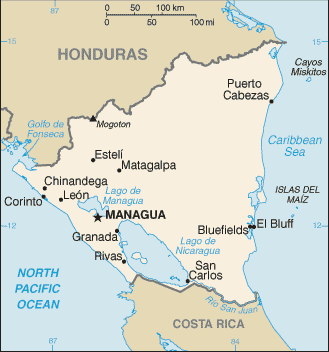|
Nicaragua
|

|
Capital: Managua
Population: 6,545,502
Brief History of Nicaragua:
Nicaragua was originally inhabited by Native American tribes. The name Nicaragua comes from Chief Nicarao who was the leader of a tribe that lived near Lake Nicaragua when the first Europeans arrived.
The first European to visit Nicaragua was Christopher Columbus in 1502. In 1524 the first permanent settlements were established by Spanish conquistador Francisco Hernandez de Cordoba. He founded the city of Granada on Lake Nicaragua and Leon near Lake Managua.
Nicaragua remained a Spanish colony until 1838. For a period of time, the British occupied a portion of the country, but slowly gave control to the local peoples.
In 1978 Nicaragua became a violent country torn with civil war. Much of the 1980s were marked with civil war and rebellion against a Marxist government that had come into power.
The Geography of Nicaragua
Total Size: 129,494 square km
Size Comparison: slightly smaller than the state of New York
Geographical Coordinates: 13 00 N, 85 00 W
World Region or Continent: Central America
General Terrain: extensive Atlantic coastal plains rising to central interior mountains; narrow Pacific coastal plain interrupted by volcanoes
Geographical Low Point: Pacific Ocean 0 m
Geographical High Point: Mogoton 2,438 m
Climate: tropical in lowlands, cooler in highlands
Major cities: MANAGUA (capital) 934,000 (2009), Leon
The People of Nicaragua
Type of Government: republic
Languages Spoken: Spanish 97.5% (official), Miskito 1.7%, other 0.8% (1995 census)
Independence: 15 September 1821 (from Spain)
National Holiday: Independence Day, 15 September (1821)
Nationality: Nicaraguan(s)
Religions: Roman Catholic 72.9%, Evangelical 15.1%, Moravian 1.5%, Episcopal 0.1%, other 1.9%, none 8.5% (1995 census)
National Symbol: turquoise-browed motmot (bird)
National Anthem or Song: Salve a ti, Nicaragua (Hail to Thee, Nicaragua)
Economy of Nicaragua
Major Industries: food processing, chemicals, machinery and metal products, textiles, clothing, petroleum refining and distribution, beverages, footwear, wood
Agricultural Products: coffee, bananas, sugarcane, cotton, rice, corn, tobacco, sesame, soya, beans; beef, veal, pork, poultry, dairy products; shrimp, lobsters
Natural Resources: gold, silver, copper, tungsten, lead, zinc, timber, fish
Major Exports: coffee, beef, shrimp and lobster, tobacco, sugar, gold, peanuts
Major Imports: consumer goods, machinery and equipment, raw materials, petroleum products
Currency: gold cordoba (NIO)
National GDP: $18,880,000,000
** Source for population (2012 est.) and GDP (2011 est.) is CIA World Factbook.
Back to Geography Home Page
